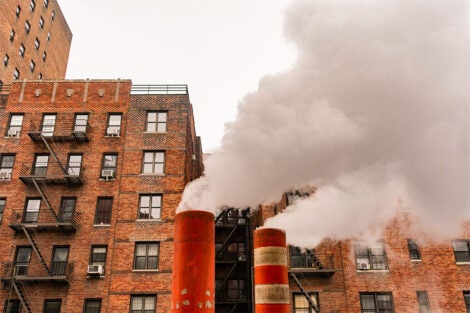Study finds lower PM2.5 exposure associated with lower mortality among whole population, but marginalized communities may benefit more
For immediate release: Friday, March 24, 2023
Boston, MA—Stronger regulations lowering levels of fine particulate air pollutants (PM2.5) would benefit the health of all Americans, but Black Americans and low-income Americans would likely reap the most benefits, including a lower risk of premature death, according to a new study led by Harvard T.H. Chan School of Public Health.
“The EPA is currently considering stronger rules for PM2.5 air pollution and the decision will have profound effects on ensuring all Americans have an equal opportunity to breathe clean air,” said co-lead author Scott Delaney, research associate in the Department of Environmental Health. “Our research shows that, while stronger rules will protect all aging Americans from air pollution, those harmed the most by air pollution will benefit the most—and that these benefits may be larger than prior research suggests.”
The study was published on March 24, 2023, in the New England Journal of Medicine.
It is the first study to examine how groups defined simultaneously by both racial identity and socioeconomic position differ in their exposure and susceptibility to PM2.5 air pollution.
Researchers utilized Medicare data from more than 73 million Americans ages 65 and older between 2000 and 2016—amounting to 623 million person-years analyzed according to racial identity (Black or White), income level (Medicaid eligible or ineligible), and annual average PM2.5 exposure by zip code.
The results showed that all aging Americans’ risk of premature death would decrease with stronger air pollution rules, but that Black higher-income, Black low-income, and White low-income adults may benefit more than White higher-income adults. Currently, the EPA’s National Ambient Air Quality Standards (NAAQS) for annual average PM2.5 levels is 12 μg/m3. The researchers found that if that standard was lowered to 8 μg/m3, the result would be an estimated 4% reduction of mortality rate for higher-income White adults, while for marginalized communities it would be considerably higher: 7% for Black higher-income and 6% for both White low-income and Black low-income adults.
“These differences result from social forces—structural racism, social exclusion, poverty—that combine in unique ways to alter the impact of PM2.5 on marginalized populations,” said co-lead author Kevin Josey, postdoctoral research fellow in the Department of Biostatistics. “However, structural racism seems to matter more than poverty when determining the health effects of air pollution.”
On January 6, 2023, the EPA announced a proposal to lower the NAAQS, one of the most important tools it uses to clean the air, to between 9 and 10 μg/m3, though it is also considering levels as low as 8 μg/m3. Public comment closes on March 28 and the agency will finalize its decision later this year.
“The EPA has a huge opportunity,” said senior author Francesca Dominici, Clarence James Gamble Professor of Biostatistics, Population, and Data Science and co-director of the Harvard Data Science Initiative. “We have a shared responsibility to safeguard the air we breathe and to protect our more vulnerable community members from the effects of climate change. Bold action from the EPA to establish a substantially stronger NAAQS for PM2.5 air pollution is a pragmatic, proven way to clean up our air, reduce the impact of climate change on human health, and drive innovative climate change solutions.”
Other Harvard Chan co-authors included Rachel Nethery and Danielle Braun.
Funding for the study came from the National Institutes of Health and the Alfred P. Sloan Foundation.
“Air pollution and mortality at the intersection of race and social class,” Kevin P. Josey, Scott W. Delaney, Xiao Wu, Rachel C. Nethery, Priyanka DeSouza, Danielle Braun, Francesca Dominici, New England Journal of Medicine, March 24, 2023, doi: 10.1056/NEJMsa2300523.
Visit the Harvard Chan School website for the latest news, press releases, and multimedia offerings.
photo: iStock/JamesAndrews
For more information:
Todd Datz
tdatz@hsph.harvard.edu
617-432-8413
###
Harvard T.H. Chan School of Public Health brings together dedicated experts from many disciplines to educate new generations of global health leaders and produce powerful ideas that improve the lives and health of people everywhere. As a community of leading scientists, educators, and students, we work together to take innovative ideas from the laboratory to people’s lives—not only making scientific breakthroughs, but also working to change individual behaviors, public policies, and health care practices. Each year, more than 400 faculty members at Harvard Chan School teach 1,000-plus full-time students from around the world and train thousands more through online and executive education courses. Founded in 1913 as the Harvard-MIT School of Health Officers, the School is recognized as America’s oldest professional training program in public health.
